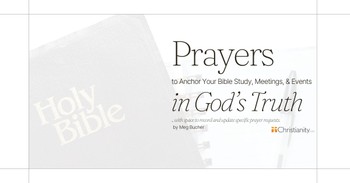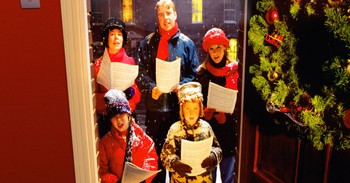Before the Israelites worshiped God in the Temple (1 Kings 6), they had a mobile worship center known as the Tabernacle, which was formed during the time of Moses (Exodus 27).
But why would they need a portable temple? Why didn’t they just build the Temple right away? And what purpose does the Tabernacle in Exodus serve? This article will cover these questions and more.
Why Build a Portable Temple?
Scanning through a brief overview of Old Testament history, we see the Israelites leave Egypt, but they didn’t settle right away. Because of their fear of the giants who roamed the land which God had promised them (Numbers 13), the Israelites wandered the desert for 40 years before they entered the Promised Land.
During those 40 years, they needed a place to worship God, but they couldn’t build a permanent temple structure because they wouldn’t live in the wilderness forever. Hence, God instructed them to build a temporary place of worship so that they could worship wherever they wandered.
Why did they need a specific place for God to dwell? Tabernacle means “to dwell.” Because God did not dwell in the hearts of humans until after Christ’s death and resurrection, he would dwell in a certain place during the time of the Old Testament. After Solomon built the Temple, he would dwell in the Holy of Holies, the most inner room of the temple where only the High Priest could enter his presence once a year (Hebrew 9:7). But, for the time being, he dwelt in the Tabernacle.
What Did the Tabernacle in Exodus Look Like?
In Exodus 27:9-19, God gives specific instructions for the construction of the Tabernacle. Although not as complex or ornate as the Temple, God laid out specific measurements and structures found within the Tabernacle.
A rectangular fence surrounded the Tabernacle. In the courtyard, between the fence and the tent (Tabernacle), you had the bronze altar (where they would perform sacrifices) and bronze laver (where the priests would wash their hands).
The tent itself had two separate rooms: The Holy Place and the Holy of Holies. Only priests could enter the Holy Place. Inside that room contained an altar of incense, a lampstand (menorah), and table of shewbread, each with their own symbolic purposes. A veil separated the Holy Place and the Holy of Holies.
Inside the Holy of Holies, the High Priest would see the Ark of the Covenant, which housed God (Exodus 37:1-9). Whenever they would move the Tabernacle from one location to the other, they would have priests carry the Ark with poles. Anyone who touched the Ark would die instantly (2 Samuel 6:7).
What Purpose Did the Tabernacle in Exodus Serve?
Until the time of Solomon (1 Kings 6), the Tabernacle offered a temporary, proper worship space for the Israelites and a temporary house for God. Plans for a new temple started a generation earlier:
"King David, Solomon’s father, lived in the royal palace, but he was concerned that God’s priests still had to serve Him in the 400-year-old, portable Tabernacle from the wilderness wanderings. David wanted to build a permanent house for God, and a resting place for the Ark of the Covenant (1 Chronicles 28:2). The prophet Nathan initially gave David approval to begin construction, but God spoke to Nathan in a dream. God said David would not be the one to build His house, even though David had a heart after God’s own heart. David would, however, draw up the plans and accumulate materials for the building (1 Chronicles 22:2-4; 22:14-17; 29:2-9)."
(Excerpted from "7 Interesting Facts about Solomon's Temple" by Dawn Wilson)
What Was the Meaning behind the Tabernacle in Exodus?
Symbolism had a great deal of importance in Israelite culture, so all of the elements within the Tabernacle would’ve had a deep meaning. It also allowed the Israelites to dwell with God and draw closer to him.
Also, through the sacrificial system held at the Tabernacle (bronze altar), the Israelites learned the gravity of their sinfulness and how much they needed a Savior. The ultimate sacrifice, Jesus, paid the penalty for us when he came to earth to “Tabernacle” with us.
Are There Hidden Symbols in the Tabernacle That Point to Christ?
Benjamin Skaug discusses how we see symbols of Christ in the Tabernacle itself.
The following is a transcript of the video above, edited for readability.
Inside that question is that word "hidden," so we have to now ask, "are there hidden symbols that are inside the tabernacle that point to Christ?" Well, that would be yes and no. The tabernacle itself, the author of Hebrews in Chapter 10, he says that merely through the repetition of sacrifices that the people knew that their sacrifices were not salvific. Then he goes on to say that it is due to the fact that the blood of bulls and goats cannot atone for sins. And so by the fact that these worshipers had to come to God and remember they could not enter into the holy of holies itself. They were held at arms distance. They can only enter into that very first layer of curtains, and so they knew that built into this perfect typological system was in fact something that could not fulfill the final function, which is to bring the worshiper into the immediate presence of God the Father.
And so, yes, in fact, you can read throughout the Gospel of John and see how Jesus Christ is the fulfillment of each station inside the tabernacle. In John 1, John the Baptist says, "Behold," as he points to Jesus Christ, "the lamb of God, who takes away the sin of the world," and there you have the first station inside the tabernacle, the altar of sacrifice. The second station inside the tabernacle is the bronze laver, that which the priest would then go after the sacrifice and wash themselves to make themselves clean. And Christ is the one whose atoning work is so perfect as the Lamb of God that he also is able to then ascend to the right hand of God the Father, and dispense the Holy Spirit to his people. And the Holy Spirit can reside within God's people because they are perfectly and spotlessly clean.
He's the fulfillment of the, as the King James would say, the shewbread. In the Hebrew language, it's called the bread of the presence or the bread of the face. It uses the Hebrew word paniym. What that means is that once the worshipers have been made clean, though they are turned away at the door, the priests every single week would go and participate in that shewbread bread and that it was a meal that was now in fellowship with God the Father. Now that their sins have been atone, for now they can eat in peace with God the Father.
And this is showing us through the work of Jesus Christ when we are made spotlessly and perfectly clean, that it points to that marriage supper of the Lamb in the Book of Revelation someday in heaven, in which we will be able, as those who have been made righteous and perfectly clean through Jesus Christ, that we will be able to have a meal paniym to paniym, face to face with the living God. And so is it hidden symbolism? It's hidden in that Paul refers to it as a mystery, but it's fully revealed and made known to us in Jesus Christ.
(“Are There Hidden Symbols in the Old Testament Tabernacle That Point to Christ?” first published on Christianity.com on February 13, 2013)
Why Does The Tabernacle Matter for Christians Today?
Why should Christians care about a temporary temple that existed during the Old Testament?
First, John 1:14 makes it clear Christ “tabernacled” with us. He came and temporarily lived with us, dwelled with us. Just like the Tabernacle, his time on earth was temporary.
But he will come again, in a more permanent fashion. Just like the Israelites had the temporary Tabernacle, but built the Temple later on, as a more permanent dwelling place.
Second, we can appreciate that God resides in our hearts and not in a temporary dwelling space. We no longer have to offer up lambs for sacrifice, because Jesus was our sacrifice.
We no longer have to have one representative once a year to approach God, we can approach him every hour of every day, and pray boldly (1 John 5:14-15).
Further Reading:
What is the Mercy Seat in the Bible?
6 Things You May Not Know about the Ark of the Covenant
Photo Credit: ©iStock/Getty Images Plus/estt
This article is part of our Bible resource for understanding the significance and meaning of biblical phrases and ideas. Here are our most popular Bible articles to grow in your knowledge of God's Word:
Promises of God in the Bible
Is "This Too Shall Pass" in the Bible?
What Was the Ark of the Covenant?
Top 10 Bible Stories for Kids
“Iron Sharpens Iron” in Proverbs 27:17
"Fearfully and Wonderfully Made" in Psalm 139
“Be Still and Know That I am God” in Psalm 46:10
"No Weapon Formed Against Me Shall Prosper" - Isaiah 54:17



.jpg)
